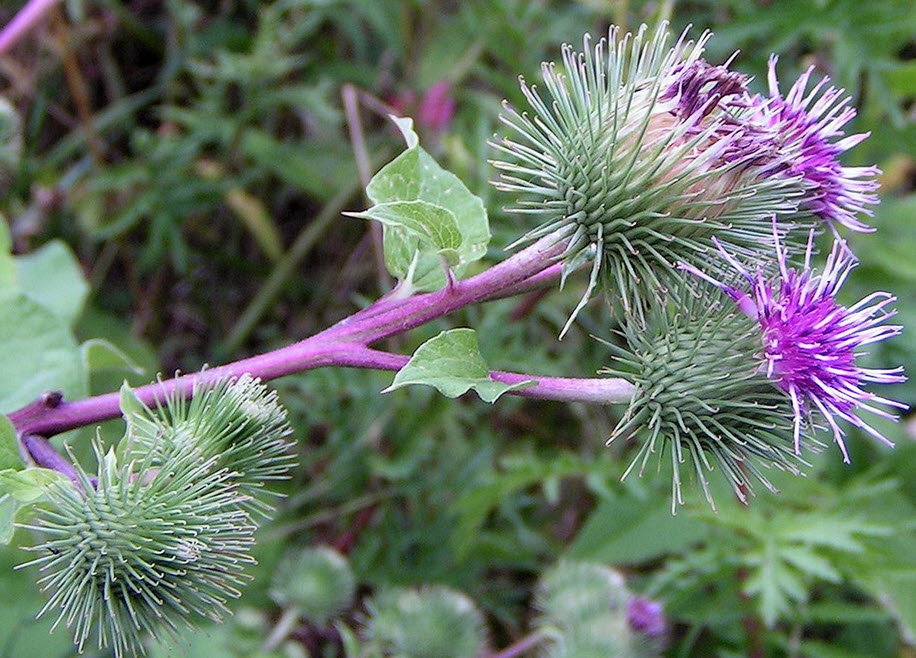Welcome to the world of herbal wonders, where ancient wisdom meets modern science.
Today, we’re taking another look into one of nature’s most tenacious tonics – Burdock. Often hailed as a ‘blood purifier’, this unassuming herb holds a treasure trove of health benefits waiting to be explored.
Whether you’re a herbal enthusiast or just curious about natural remedies, let’s uncover the secrets of Burdock together!

Image Source: Wikimedia (image cropped)
Burdock: Unveiling Its Secret Powers
The Potent Powers of Burdock Explained
Burdock root, known scientifically as Arctium lappa, is more than just a plant; it’s a powerhouse of health.
Traditionally described as an “alterative,” it’s believed to help the body cleanse itself, particularly the bloodstream. This detoxifying action is thought to stem from its high antioxidant content, which helps combat free radicals and support overall health.
Moreover, its potential role in cancer treatment, though still under study, adds to its intriguing therapeutic profile.
Rooted in Tradition: Burdock’s Heritage in Herbal Remedies
Long revered in traditional medicine systems like Ayurveda and Traditional Chinese Medicine, Burdock has been used for centuries to treat a variety of ailments.
From skin conditions to digestive issues, its history as a healing herb is rich and diverse.
Today, it continues to be a staple in herbal remedies, testament to its enduring therapeutic value.
A Journey Through Time: Burdock’s Origin and Lore
The story of Burdock is as fascinating as its benefits. Native to Europe and Asia, it has journeyed across continents, embedding itself in folklore and traditional healing practices.
An interesting tale is its inspiration for Velcro – the burrs of the plant clinging to clothing sparked the idea in the inventor, George de Mestral!
Scientific Scrutiny: Research on Burdock
While the traditional uses of Burdock are well-documented, modern science has begun to peel back the layers of this complex herb.
Studies have focused on its potential anti-inflammatory and antioxidant properties, with some research exploring its role in supporting cancer treatment.
Some studies show anti-tumor or anti-mutation activity.
However, it’s important to note that much of this research is still in preliminary stages.
The National Cancer Institute became interested in burdock as part of its Designer Foods Program, an effort to use biotechnology to introduce cancer-preventive chemicals into common food crops. Its action is mild, but real.
It has antibacterial and antiviral powers, and it reduces blood sugar, which helps prevent diabetes. It has value as a tonic, a subtle strengthener with cumulatively helpful effects.
Burdock’s Biochemical Blueprint
What makes this one a standout herb? It’s all in its constituents.
- Inulin, a prebiotic fiber, aids digestion.
- Polyacetylenes are thought to have antimicrobial and antifungal properties.
- Flavonoids and phenolic acids contribute to its antioxidant profile.
These components work synergistically to support the body’s natural detoxification processes.
The root contains high amounts of inulin and mucilage. This may explain its soothing effects on the gastrointestinal tract. Bitter constituents in the root may also explain the traditional use of burdock to improve digestion.
It also contains polyacetylenes, shown to have antimicrobial activity.
Burdock root and fruit also have the ability to mildly lower blood sugar (hypoglycemic effect).
Historical Use
It was believed to clear the bloodstream of toxins. Used both internally and externally for eczema and psoriasis, it was also used to treat painful joints and as a diuretic.
In traditional Chinese medicine, burdock root in combination with other herbs is used to treat sore throats, tonsillitis, colds, and even measles.
Additionally, it is eaten as a vegetable in Japan and elsewhere.
Dosage: How Much Is Just Right?
When it comes to incorporating Burdock into your regimen, moderation is key.
Standard dosages can vary, but a common recommendation is about 2-4 grams of the root daily, often taken in the form of tea or supplements.
As always, it’s best to consult with a healthcare provider for personalized advice.
Incorporating Burdock Into Your Health Routine
The root can be enjoyed in several forms – as a tea, a cooked vegetable, or even as a supplement.
Moreover, its earthy, slightly sweet flavor makes it a versatile addition to soups and stews.
Burdock tea, in particular, is a simple and soothing way to enjoy its benefits.
To brew a pleasantly sweet-tasting tonic tea, boil one teaspoon of crushed, dried root in three cups of water for 30 minutes. Drink up to three cups a day.
Precautions:
While it is generally safe, it’s crucial to be mindful of possible interactions and allergies.
Pregnant or breastfeeding women should avoid it, and those with a history of allergies to plants in the Asteraceae family should proceed with caution.
Again, as I have said, always consult a healthcare professional before starting any new supplement.

Christian Fischer, CC BY-SA 3.0, via Wikimedia Commons
A Closer Look at the Plant
Burdock is easily recognizable by its large, heart-shaped leaves and small burr-like flowers.Native to Asia and Europe, it’s a hardy biennial plant, thriving in various environments.
The part most commonly used for its medicinal properties is the root, harvested in the plant’s first year.
Conclusion: Embracing Burdock’s Bounty
In conclusion, Burdock is more than just a herb; it’s a testament to nature’s ability to provide healing.
Its rich history, coupled with emerging scientific interest, makes it a fascinating addition to the world of herbal remedies.
Whether you’re looking to detoxify your body, support overall health, or simply explore natural healing, Burdock offers a versatile and potent solution.
Remember, nature often holds the key to our well-being, and in the case of Burdock, it’s a key worth turning.
